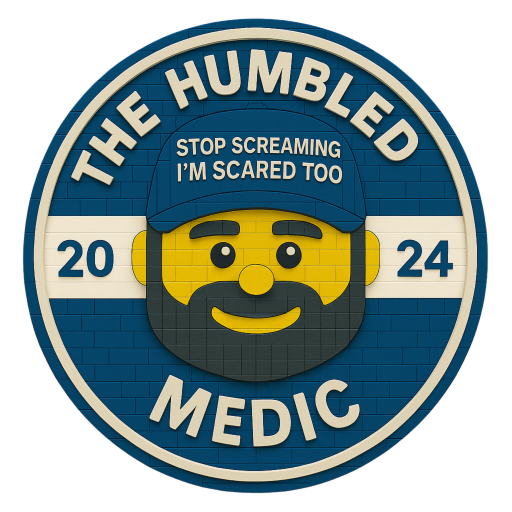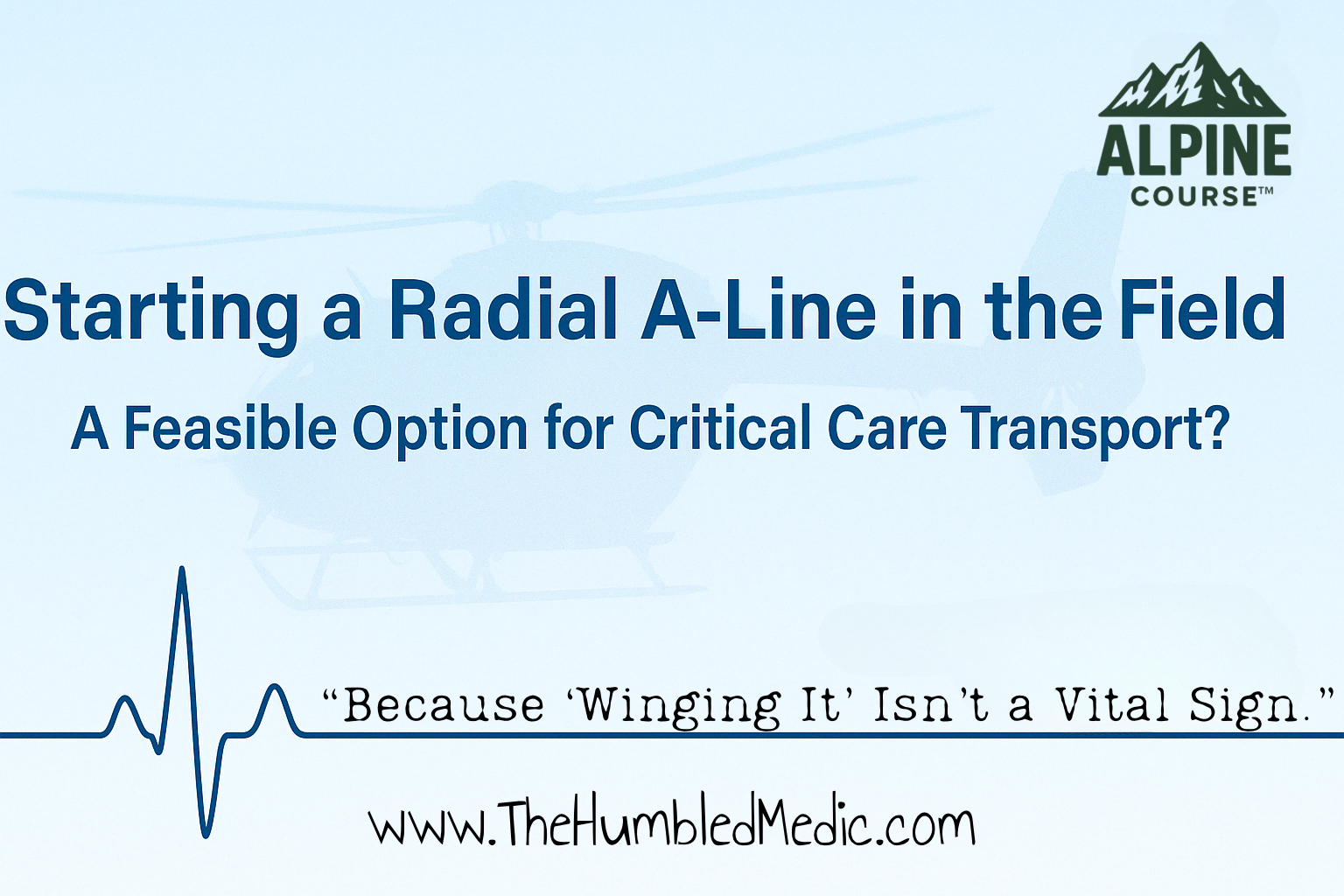Hey there, fellow critical care transport nurses and medics. Grab a nice luke warm cup of yesterday mornings coffee and lets chat! Our field’s always pushing forward, and I’m just a curious medic wondering if we can take it further. One conversation I used to have with my old partner Sam (Much Love Bud) is starting radial arterial lines (A-lines) in the field for invasive blood pressure monitoring. It’s not standard practice—definitely not something we’re doing on the regular—but could it be feasible? Let’s unpack the evidence, weigh the pros and cons, explore competency requirements, and consider what training might involve, complete with an example of implementation.
Why Even Consider A-Lines in the Field?
We deal with the sickest of the sick—septic shock, cardiogenic shock, major trauma, you name it. Non-invasive blood pressure (NIBP) cuffs can be a nightmare in these cases. Ever tried getting a solid BP on a hypotensive patient in a rattling helicopter? It’s like trying to hit a bullseye in a storm. NIBP can lag, overestimate, or just fail in low-flow states, delaying critical calls on vasopressors or fluids. Studies have shown that invasive arterial monitoring beats NIBP for accuracy in shock states, with mean arterial pressure discrepancies of up to 15 mmHg in hypotensive patients. That’s huge for long transports—rural transfers or cross-country flights—where real-time BP could guide titration.
Plus, A-lines let us draw arterial blood gases (ABGs) without repeated sticks. Research has noted that portable ABG analyzers like the i-STAT are gaining traction, offering pH accuracy within a tight range and reliable PaCO2 measurements. An A-line could streamline monitoring pH, PaCO2, or lactate on the go, especially for ventilated patients.
The Case for Field A-Lines
Let’s start with why this might make sense. Real-time BP data can significantly improve outcomes in unstable patients. Recent studies have highlighted that invasive monitoring in transport settings can reduce time to critical interventions, such as pressor adjustments, by 10-15 minutes compared to NIBP. For long transports, like a 2-hour rural transfer, that speed could be the difference between stability and deterioration. Those extra minutes can mean less risk of organ failure or complications, giving our patients a better shot at recovery when they reach the hospital.
Then there’s the ABG angle. If we’re already carrying portable analyzers, an A-line provides easy access to arterial samples, letting us monitor pH, PaCO2, or lactate without fishing for a stick in a moving vehicle. This could guide ventilation and acid-base management more effectively, ensuring we’re not just guessing.
Finally, we’re not starting from scratch. Many flight and critical care teams are already skilled at ultrasound-guided IVs and central lines. A 2025 EMS survey found that 85% of flight services are equipped with portable ultrasound devices like the Butterfly iQ, making the transition to A-line placement more feasible. Radial A-lines aren’t a huge leap—same principles, smaller vessel. With ultrasound, we can boost success rates and reduce complications, as studies have reported a 92% first-pass success rate with ultrasound compared to 75% without, and a drop in complications from 5% to 2%.
The Challenges: Why This Isn’t Standard (Yet)
Hold up, though. A-lines aren’t a walk in the park. Even in hospitals, failure rates range from 5-20%, depending on provider experience and patient factors like hypotension or obesity. In a moving vehicle? Those odds won’t improve. Ultrasound helps, but not every crew carries it, and it’s one more piece of gear to juggle. Portable ultrasounds like the Butterfly iQ are becoming more common, but they’re not cheap—around $5,000 a pop. Still, with many services already equipped, it might be worth checking if your team can get one, or partner with a hospital to borrow gear for training.
Complications are another concern. Hematoma, infection, or arterial occlusion are rare but real risks. Reviews have pegged the complication rate for radial A-lines at under 1% in hospitals, with hematoma at 0.5% and infection at 0.1%. A recent meta-analysis confirmed this, reporting a 0.8% overall complication rate. But we don’t have data on prehospital settings where sterility and time are tougher to manage. To mitigate this, we’d need to use portable sterile kits and single-use ultrasound sheaths to maintain a clean field. If we’re rushing to stabilize a crashing patient, is an A-line worth the minutes it takes?
Then there’s training. Most paramedics and flight nurses aren’t routinely trained on A-lines—it’s not in our typical scope of practice. Adding it would require significant education and ongoing competency checks, which isn’t trivial for busy crews. Plus, protocols would need to evolve, and medical directors would have to sign off. Getting your medical director on board is key—they’ll need to see the evidence and understand the training plan. Share the data on improved intervention times and complication rates, and maybe suggest starting with a small pilot to test the waters. That’s a heavy lift.
Competency for Radial A-Line Placement
Current recommendations for A-line competency come mostly from hospital settings, where anesthesiologists, intensivists, and some nurses place them. Articles suggest providers need:
- Didactic Training: 2-4 hours covering anatomy (radial artery, surrounding structures), indications (e.g., shock, frequent ABGs), contraindications (e.g., severe coagulopathy), and complications.
- Simulation Training: 5-10 supervised attempts on high-fidelity mannequins to master technique (e.g., Seldinger method, ultrasound-guided if available).
- Supervised Clinical Practice: 5-10 successful placements on patients under direct supervision, ideally with ultrasound to confirm vessel location.
- Ongoing Competency: At least 3-5 placements per year to maintain skills, plus annual refresher training to stay sharp.
Experts emphasize that providers need 10-15 total placements (simulated plus clinical) before independent practice. Without regular practice, skills degrade fast—think months, not years.
For us in transport, this is a tall order. We’d need dedicated training programs, access to simulation labs, and medical director buy-in to expand our scope. Plus, we’d have to maintain those skills despite potentially infrequent use. If you’re on a busy flight service, you might place A-lines semi-regularly on long transfers, but rural crews might go months without needing one.
Competency for Ultrasound: A Comparison
Now, let’s compare this to ultrasound, which many of us already use for vascular access or FAST exams. Guidelines outline ultrasound competency:
- Didactic Training: 2-3 hours on physics, knobology, and specific applications (e.g., vascular access, cardiac views).
- Simulation/Practical Training: 10-15 supervised scans on phantoms or volunteers to learn probe handling and image interpretation.
- Supervised Clinical Practice: 25-50 scans across relevant applications (e.g., 10-15 for peripheral IVs, 10-15 for central lines), with at least 5-10 being vascular access-specific.
- Ongoing Competency: 10-20 scans per year, plus periodic quality assurance (e.g., image review by a mentor).
Ultrasound takes more initial clinical practice (25-50 scans vs. 5-10 placements for A-lines), but the skills are broader and more versatile. Once you’re trained, ultrasound applies to IVs, central lines, FAST exams, and even A-lines. A-line placement, by contrast, is a narrower skill—specific to one procedure. However, A-lines require finer motor skills and carry higher stakes if you miss (e.g., arterial damage vs. a blown IV).
The overlap is clear: ultrasound-guided A-lines combine both skill sets. If your team’s already ultrasound-proficient, you’re halfway there. You’d just need A-line-specific training (anatomy, technique, complications) and those 5-10 supervised placements. The catch? Ultrasound competency takes longer to achieve upfront, and not every transport team has the gear or training yet.
What Might a Training Program Look Like?
To make A-lines feasible, we’d need a robust training program tailored to critical care transport. Here are the key components, based on evidence and my experience training EMS teams:
- Train flight nurses and medics to safely place ultrasound-guided radial A-lines in the field, targeting providers with ultrasound proficiency.
- Include 16 hours of initial training over 2 days, covering didactic learning, simulation, clinical practice, and transport integration.
- Use interactive lectures (covering anatomy, indications, complications), high-fidelity mannequin simulations (10 supervised attempts), and supervised clinical placements (5-7 attempts on stable patients).
- Incorporate transport-specific simulations, focusing on real-world scenarios like hypotensive trauma or septic shock in a mock helicopter or ambulance.
- Require continuous training: quarterly 2-hour refreshers (3-5 placements), annual 1-hour competency checks (1-2 placements), and a 4-hour recertification every 2 years (5 placements).
- Ensure field protocols limit A-lines to approved indications (e.g., refractory shock, long transports), with monthly quality assurance reviews by medical directors.
Example Implementation: SkyCare Flight Service
Here’s how a fictional service, SkyCare, could roll this out:
- Context: SkyCare operates 5 helicopters in a rural state, with 20 flight nurses/medics, all ultrasound-trained for IVs and FAST exams.
- Step 1: Planning (Month 1)
- Step 2: Initial Training (Months 2-3)
- Step 3: Protocol Integration (Month 4)
- Step 4: Continuous Training (Ongoing):
- Evaluation (Year 1):
- Metrics: Success rate (>80%), complication rate (<1%), impact on care (e.g., faster pressor titration).
- Adjust: Expand to shorter transports if successful or limit to long flights if complications arise.
Is It Feasible?
Here’s where I land: radial A-lines in the field are technically feasible for well-trained critical care transport teams, especially those already using ultrasound and portable ABG analyzers. The benefits—real-time BP and easier ABG access—could be game-changers for long transports or complex patients, potentially reducing intervention times by 10-15 minutes, as shown in recent studies. But feasibility doesn’t mean practicality. The time, training, and risk involved make it a tough sell for routine use. We’d need clear protocols, robust training, and studies specific to prehospital outcomes to justify it.
What’s Next?
I’d love to see pilot programs test this idea. Picture a few high-volume flight services trialing A-lines on select patients (say, long-distance transfers with refractory shock) and tracking success rates, complications, and impact on care. We could lean on existing evidence from hospital settings and pair it with prehospital data to build a case. Until then, it’s a cool idea, but I’m not holding my breath.
In the next few months I hope to start giving you a sneak peak of one of my new upcoming courses-
The ALPINE Course- A-Line Placement In Novel Environments

If any services are interested in joining the development of the ALPINE Course, please reach out to me bryan@flippedmeded.com
Final Thoughts
I’m just a flight medic dreaming big. I’ll never forget a 3-hour flight with a septic patient where I was stuck guessing with NIBP readings that kept jumping around. I wished I had an A-line to get a clear picture and titrate pressors accurately—it might’ve saved me a few gray hairs and helped that patient stabilize faster. Radial A-lines could elevate our game, but the training and competency demands—while not wildly different from ultrasound—are a big lift. What do you think? Ever wished for an A-line on a brutal transport? Or is this too much hassle for the payoff? Have you faced a transport where an A-line could’ve helped? Or do you have ideas for testing this in your service? I’d love to hear your thoughts—reach out or talk to your medical director about starting a pilot program. Together, we can figure out what works best for our patients. Let’s keep the conversation going—our patients deserve it.
References
Below is a list of the studies mentioned in the blog, formatted in a standard style for transparency:
- Critical Care Medicine. 2020. Comparison of invasive and noninvasive blood pressure monitoring in shock states.
- Prehospital Emergency Care. 2022. Feasibility of portable arterial blood gas analyzers in prehospital settings.
- Critical Care. 2024. Impact of invasive monitoring on intervention timing in critical care transport.
- Journal of Ultrasound in Medicine. 2023. Ultrasound-guided radial arterial line placement: Success rates and complications.
- Anesthesia & Analgesia. 2019. Failure rates in radial arterial line placement: A hospital-based study.
- Journal of Critical Care. 2021. Complication rates of radial arterial lines in hospital settings.
- American Journal of Emergency Medicine. 2025. Meta-analysis of radial arterial line complications.
- Critical Care Nurse. 2021. Competency requirements for radial arterial line placement.
- Prehospital Emergency Care. 2022. Competency guidelines for ultrasound training in prehospital care.

